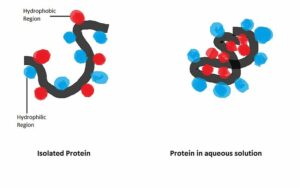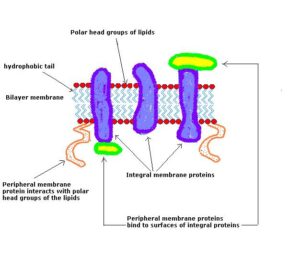The word Hydrophilic means water-loving, the affinity towards water molecules. A hydrophilic moiety of a molecule that has a high affinity or attraction for water.
Here is the list of hydrophilic protein examples:
- Peripheral protein
- Integral protein
- Glycophorin
- Albumin protein
- ATP Binding protein
Peripheral protein
The peripheral protein which exists on the plasma membrane is also known as a membrane peripheral protein that are act as a hydrophilic because this protein never crosses the hydrophobic region and always adheres to the outside or outer surface of the phospholipid bilayer. The water can do electrostatic interactions with the head of phospholipids
The proteins are associated with the cellular membrane via some common enzymes or some weak interactions. The protein shows some hydrogen bonding interactions and electrostatic interactions with the hydrophilic region of integral proteins or the polar head group of membrane lipids.
Peripheral protein can also be either external or internal having no plasma membrane domain that floats on the membrane-like a raft with few weak interactions with the lipid bilayer. It is the most common example is a hydrophilic protein.
There are many important roles of peripheral proteins in the cell to cell communication as well as cell signaling pathways. Due to their hydrophilic nature, the cell can easily get a response or signal from the outside for the entry or penetration of any useful substances from the outside the cell. Due to their polarity and solubility, compounds can easily attract water via weal interactions.

Image from Wikimedia.org
There are different examples of peripheral proteins that are flavoproteins, ferredoxins, cytochrome c, high potential iron protein, and many more.
Integral protein
Most of the integral proteins are embedded in the region hydrophobic, having non-polar amino acids but some exposed ends of integral protein are found on the hydrophilic side. The integral protein is completely embedded in the phospholipid bilayer that contains both hydrophobic as well as hydrophilic regions.
Some parts of the integral proteins pass from the hydrophilic region of the membrane mainly the exposed end which can easily solubilize rather than another non-polar hydrophobic region.

Image from Wikimedia.org
Glycophorin
This protein is hydrophilic that is also known as a sialoglycoprotein of the membrane of red blood cells. It can also be known as a membrane-spanning protein.
It has a very hydrophilic charged coat due to the presence of sialic acid and around 60% glycosylated thus it can circulate without attaching to the wall or other cells. There are three types of glycophorin protein including glycophorin A,B and C.
Albumin protein
This protein is hydrophilic which helps to maintain and stabilize extracellular fluid volume and provide nutrition all over the tissue.
The protein is mainly found in blood serum. It is also a part of a family of proteins also known as a globular protein that is mainly responsible for various functions like cell signaling, regulation, transport, catalysis, and immunity.
There are some different amino acids are also act as hydrophilic. Some hydrophilic protein examples are Aspargine, Tyrosine, Threonine, Glutamine, serine, and many more, Some other proteins also act as hydrophilic include cellulose, glucose, starch, sodium chloride, sodium hydroxide, and many more.
ATP Binding Protein
This is the most common hydrophilic protein example.The ATP binding component is act as a hydrophilic component.ATP binding protein mainly responsible to provide a one binding site and allow the ATP molecule to interact.After the biniding of ATP, it can release the energy in the form of ADP that is utilize by the protein for their different kind of activity.
Conclusion
The hydrophilic proteins are always polar because they are water-loving and easily solubilize with other particular substances or compounds which have a polar structure. The non-polar compounds or proteins are always act as a hydrophobic rather than hydrophilic.
Also Read:
- Is adenine a pyrimidine
- Is diffusion directional
- Is adenine a nucleotide
- Do bacteria have enzymes
- Function of vacuole in animal cell
- Meiosis stages 2
- When does the cytoplasm divide
- Does facilitated diffusion require energy
- Is diffusion passive
- Perennial plant example

Hello, I am Bhairavi Rathod, I have completed my Master’s in Biotechnology and qualified ICAR NET 2021 in Agricultural Biotechnology. My area of specialization is Integrated Biotechnology. I have the experience to teach and write very complex things in a simple way for learners.